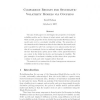Free Online Productivity Tools
i2Speak
i2Symbol
i2OCR
iTex2Img
iWeb2Print
iWeb2Shot
i2Type
iPdf2Split
iPdf2Merge
i2Bopomofo
i2Arabic
i2Style
i2Image
i2PDF
iLatex2Rtf
Sci2ools
FS
2010
2010
Comparison results for stochastic volatility models via coupling
The aim of this paper is to investigate the properties of stochastic volatility models, and to discuss to what extent, and with regard to which models, properties of the classical exponential Brownian motion model carry over to a stochastic volatility setting. The properties of the classical model of interest include the fact that the discounted stock price is positive for all t but converges to zero almost surely, the fact that it is a martingale but not a uniformly integrable martingale, and the fact that European option prices (with convex payoff functions) are convex in the initial stock price and increasing in volatility. We give examples of stochastic volatility models where these properties continue to hold, and other examples where they fail. The main tool is a construction of a time-homogeneous autonomous volatility model via a time change.
| Added | 25 Jan 2011 |
| Updated | 25 Jan 2011 |
| Type | Journal |
| Year | 2010 |
| Where | FS |
| Authors | David Hobson |
Comments (0)

